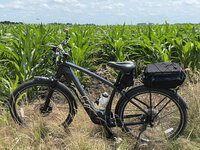Yes, that will be off-road. That's why mountain bikes for riding technical single track are fully suspended, and the higher jumps are expected the longer suspension travel is used. During my over 1 year ownership of Trance E+ Pro (150 mm travel front, can't remember the damper travel) only half of the suspension travel was utilized max. It is because MTB forks are designed to withstand jumps, and I never jumped on my e-MTB.
Specialized install very expensive FutureShock suspension stem on their road/gravel bikes and e-bikes, and the 1.5 version has the 20 mm travel. Cannondale offers their Lefty suspension fork for their gravel e-bikes, and the travel is just 20 mm there, too. That's exactly what is necessary for the ride comfort. The rest is for the traction. (Necessary to mention such bikes and e-bikes are lightweightWe have some nasty exposed roots on my local trails. Potholes, too. Both are helped by full suspension.


